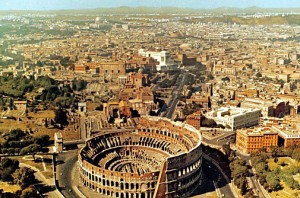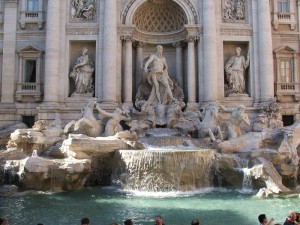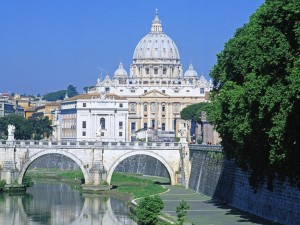This article is written by Cyrus Dadachanji, an avid food journalist, storyteller, non-fiction film and TV scriptwriter, researcher, advertising copywriter and poet, based in Mumbai
Rome is probably the only city in the world that’s so steeped in history, that it’s more proud of its ruins than of the structures still erect! Truly, a city you could easily lose your heart to!
Welcome to the Capital of what was one of the greatest empires in the world, and today is the Capital of Christendom. Welcome to Rome. The only city in the world that actually has a city within a city. Rome boasts of a rich and varied heritage. A legacy of power and opulence that oozes from every pore of the city. Where every crumbling brick has its own tale to tell. Tales of treachery, deceit, power-broking, hedonism or love. Rome is the city of faith and love alike. Where God and Cupid, seemingly inhabit every avenue, every Church and every street corner. For only in Rome are history and passion so intricately intertwined that one would be nothing without the other.
Rome is an art lover’s idea of Paradise. The city is teeming with historical monuments, paintings, sculptures, temples, basilicas and architecture that’s so rich in its diversity, that it would probably take a person a few months, if not longer to appreciate it all. However, Rome’s real attraction lies in the remnants of its ancient history and the only way to truly appreciate the grandeur of the city 2, 000 years ago, is to walk around it. And as you do, Rome will surely take your breath away, every time you round a corner.
“Rome is a city that has been built many times upon itself, layer upon layer.”
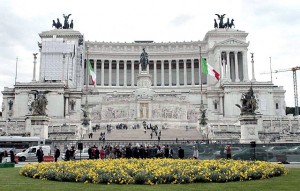 Let’s begin our stroll around Rome at the Piazza Venezia, which is almost at the centre of the city. The Piazza is the site of a giant marble monument built to honour unified Italy’s first king, Victor Emmanuel II. This relatively modern monument, with its towering Greek columns, just gives you an idea of the scale of construction, when the Empire was in its heyday. Walk around the monuments, up a majestically sweeping flight of steps, designed by Michaelangelo, to the ancient seat of power, Capitol Square on Capitoline Hill. The Palazzo Senatario across the Square is an ornate palace that’s still the ceremonial seat of Rome’s City Hall. But it is not as simple as it seems. Rome is a city that has built been many times upon itself, layer upon layer. Churches replacing ancient Roman temples. Monuments to one conqueror obliterating his predecessors’. And so on Capitoline Hill too, the Palazzo Senatario s actually built on the ancient Tabularium, where Rome’s archives were once stored. Ring out the old, ring in the new.
Let’s begin our stroll around Rome at the Piazza Venezia, which is almost at the centre of the city. The Piazza is the site of a giant marble monument built to honour unified Italy’s first king, Victor Emmanuel II. This relatively modern monument, with its towering Greek columns, just gives you an idea of the scale of construction, when the Empire was in its heyday. Walk around the monuments, up a majestically sweeping flight of steps, designed by Michaelangelo, to the ancient seat of power, Capitol Square on Capitoline Hill. The Palazzo Senatario across the Square is an ornate palace that’s still the ceremonial seat of Rome’s City Hall. But it is not as simple as it seems. Rome is a city that has built been many times upon itself, layer upon layer. Churches replacing ancient Roman temples. Monuments to one conqueror obliterating his predecessors’. And so on Capitoline Hill too, the Palazzo Senatario s actually built on the ancient Tabularium, where Rome’s archives were once stored. Ring out the old, ring in the new.
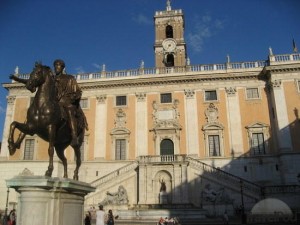 Step into the Capitoline Museum across the Square to see a wonderful statue of Marcus Aurelius, Rome’s finest military strategist on horseback. The Museum also has a 2500 year old bronze statue of a wolf which supposedly reared Romulus after whom Rome was named along with various busts of Ceasers over the centuries and some impressive mosaic work retrieved from Hadrian’s Villa among its other art treasures. In the courtyard of the Palazzo de Conservatori, opposite the Museum, lie the remnants of what was once a giant statue of Emperor Constantine, looking onto the Roman Forum. The head of the statue alone is eight and a half feet tall! The various parts of the statue are arranged around the courtyard and make a perfect photo opportunity.
Step into the Capitoline Museum across the Square to see a wonderful statue of Marcus Aurelius, Rome’s finest military strategist on horseback. The Museum also has a 2500 year old bronze statue of a wolf which supposedly reared Romulus after whom Rome was named along with various busts of Ceasers over the centuries and some impressive mosaic work retrieved from Hadrian’s Villa among its other art treasures. In the courtyard of the Palazzo de Conservatori, opposite the Museum, lie the remnants of what was once a giant statue of Emperor Constantine, looking onto the Roman Forum. The head of the statue alone is eight and a half feet tall! The various parts of the statue are arranged around the courtyard and make a perfect photo opportunity.
In the valley below the Capitol Hill lies Rome’s most revered ruins after the Colosseum, The Roman Forum. The Forum was the seat of Government, Commerce and Religion, drawing all of Rome to its majestic halls and temples over two thousand years ago.As you walk around the Forum, the sheer grandeur of Rome as it was begins to dawn on you. What were once giant meeting halls and temples are today reduced to rubble, thanks to age, neglect or sheer vandalism in many cases. Two thousand years ago, the processions of Roman emperors passed by the Temple of Antonio and Faustina, Marcus Aurelius’s foster parents, as crowds cheered by the thousand.
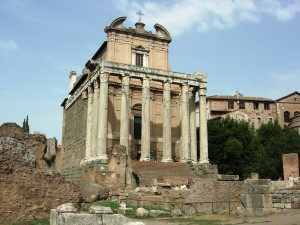 Temple of Antonio and Faustina
Temple of Antonio and Faustina
Rome’s prosperity can be judged from the ruins of Basilica Amelia, an ancient convention centre built in 179 BC. Note the green stains on the wall caused by the destruction of Copper coins, when the Goths attacked Rome and pillaged the city. The Curia, in the Forum is where the senate met and discussed matters of state, often aided by the predictions of seers and astrologers. The Forum also has its fair share of arches and temples celebrating conquests great and small as well as glorifying a hedonistic lifestyle. Any tour of the Forum would be incomplete without a mention of the Temple of Vesta, where Vestal Virgins once tended an eternal flame and if it went out, the lax virgin would pay for it with her life. Strange, how some things never seem to change…
“Each edifice is grander and more opulent than the last. And the Colosseum is the perfect example of the Roman penchant for imposing constructions.”
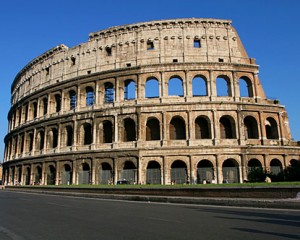 Walk around Rome and it would seem as though the word small didn’t exist in the ancient Roman’s dictionary. Each edifice is grander and more opulent than the last. And the Colosseum is the perfect example of the Roman penchant for imposing constructions. Constructed in 80 A.D., the Colosseum must have been the largest open-air amphitheatre in the world, in its day. It was faced with marble and had a huge stone arena with three tires of shaded viewing galleries capable of seating upto 50, 000 spectators! And if the construction seems grand, the programmes held here would put most of our modern day spectacles into the shade. The inaugural games lasted for 100 days, with races and gladiators fighting each other, when they weren’t fighting wild beasts. It is reported that over 5000 wild animals were killed on the first day of the games! Today, the floor of the Colosseum is no more and one can see a maze of cubicles and cells, where the wild beasts and gladiators were kept, before they were brought up to meet their respective destinies!
Walk around Rome and it would seem as though the word small didn’t exist in the ancient Roman’s dictionary. Each edifice is grander and more opulent than the last. And the Colosseum is the perfect example of the Roman penchant for imposing constructions. Constructed in 80 A.D., the Colosseum must have been the largest open-air amphitheatre in the world, in its day. It was faced with marble and had a huge stone arena with three tires of shaded viewing galleries capable of seating upto 50, 000 spectators! And if the construction seems grand, the programmes held here would put most of our modern day spectacles into the shade. The inaugural games lasted for 100 days, with races and gladiators fighting each other, when they weren’t fighting wild beasts. It is reported that over 5000 wild animals were killed on the first day of the games! Today, the floor of the Colosseum is no more and one can see a maze of cubicles and cells, where the wild beasts and gladiators were kept, before they were brought up to meet their respective destinies!
It’s a long pleasant walk from the Colosseum to the Baths of Caracalla. And from a world of imagined pomp and excitement, to a more relaxed environment. The Baths, built in 217 AD, were the equivalent of a modern day athletic club-cum-sauna. These public baths were open to the common public who were free to bathe in the pools, exercise or read what they willed in the libraries around the complex. Used for over 400 years, the Baths now lie in ruins, but are often the setting for enchanting operatic performances.
Talking about water, another facility the common Romans enjoyed, was clean drinking water at fountains strategically placed around the city. The most famous of these of course is the Trevi Fountain. The fountain in its present form was built in the 1700’s to incorporate a depict wild fantasies about mythical sea serpents, splashing about amid the cascading waters of the fountain. Legend has it that if you toss a coin into the fountain, you’ll surely return to Rome some day.
Rome needs no legends to make a casual visitor vow to return. If any visitor hasn’t yet been bowled over by Rome’s charms (remember, Cupid is Roman too), a visit to Vatican City will do the trick. Measuring only 108 acres, it is probably the world’s tiniest independent state. Nevertheless, it is the seat of power of all Christendom, and the residence of the Pope- giving it an influence that belies its size. The Vatican is also the repository of some of the world’s finest art treasures, including many of Michaelangelo’s greatest works.
St. Peter’s Basilica
Our tour of this tiny state begins at the mammoth St. Peter’s Basilica. You approach the Basilica along a broad avenue, which allows the eyes to adjust to its dimensions. The piazza or square of the Basilica is actually an oval paved area enclosed by four rows of coulmns. The columns are so ingeniously positioned that they suddenly merge to form a single row, when seen from a certain spot in the piazza. St. Peter’s Basilica is still guarded by Swiss guards garbed in a colourful uniform, designed by Michaelangelo himself. The first Basilica, constructed in 400 AD, finally crumbled in the 1400’s and was rebuilt over the next two hundred years, with the architectural genius of five architects, including Raphael and Michaelangelo, to attain its present grandeur. The Basilica is full of extraordinary works of art, the most famous of which is Michaelangelo’s Pieta. A bronze statue of St. Peter stands testimony to the faith people have in him. Look at his toe and you’ll see that it has been worn thin over the years, by millions of kisses showered upon it. As you wander down the aisles and around the relics, St. Peter’s Basilica is sure to leave you in awe of the artistry of the Great Masters. In fact, most of the paintings above the altar and adorning the walls are actually mosaic work, done using millions of tiny tiles, to achieve various degrees of light and shade! That’s patience for you!
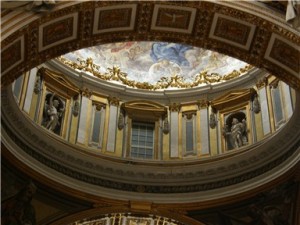 Artworks in St. Peter’s Basilica’s dome
Artworks in St. Peter’s Basilica’s dome
While you’re at St. Peter’s, give yourself a treat. Climb to the top of the dome or take the elevator and you’ll see Rome for what it really is. An incredibly well planned city with lots of gardens and green areas adjoining broad avenues, flanked on either side by stately buildings. And ruins, of course. But, thankfully missing from the skyline are those ugly modern monstrosities called skyscrapers. For all its modernity, Rome is a city that truly cherishes the past and would like to keep much of it the same. Before you leave the Basilica, do drop in at the Treasury to get a glimpse of the true wealth of the Church. The sheer richness of the items used by the Popes in the past could make a King green with envy. Talking of green, you’ll feel like taking a little guided tour around the lush Vatican gardens after a visit to the treasury. If only to catch your breath, that is.
“The Vatican Museum in the same complex has the finest collection of religious art in the world, not to mention Michaelangelo’s greatest masterpiece- The Sistine Chapel.”
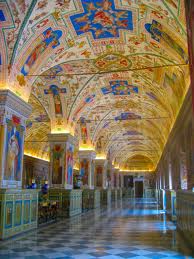 The Vatican Museum in the same complex has the finest collection of religious art in the world, not to mention Michaelangelo’s greatest masterpiece- The Sistine Chapel. The ceiling of the Sistine Chapel, measuring around 10, 000 square feet, has scenes from the Book of Genesis, painted by Michaelangelo. The entire task was executed over a period of twelve years as he lay flat on his back, supported by a specially constructed scaffolding! Despite the sheer size and nature of the job, Michaelangelo has not compromised on the details. However, he has painted himself into the picture, holding his own skin! I suppose every artist likes to have the last word -even if he has to paint it!One could wax eloquent about almost every edifice in Rome, for it seems to have no dearth of architectural wonders to match its artistic treasures. However, no visit to Rome would be complete without a visit to the Pantheon. Built in 125 AD, the Pantheon in its present form is a temple to all the Gods. However, what makes this circular building an architectural masterpiece is its dimensions. Its diameter is equal to its height and the open centre, which incidentally was conceived as a sundial, is its only source of light. The Pantheon is now the resting-place of two of Italy’s finest artists as well as two kings! The Pantheon is a treat to visit at any time of the day or night…if only to see the light streaming in through the columns… making it a truly befitting resting place for a king.
The Vatican Museum in the same complex has the finest collection of religious art in the world, not to mention Michaelangelo’s greatest masterpiece- The Sistine Chapel. The ceiling of the Sistine Chapel, measuring around 10, 000 square feet, has scenes from the Book of Genesis, painted by Michaelangelo. The entire task was executed over a period of twelve years as he lay flat on his back, supported by a specially constructed scaffolding! Despite the sheer size and nature of the job, Michaelangelo has not compromised on the details. However, he has painted himself into the picture, holding his own skin! I suppose every artist likes to have the last word -even if he has to paint it!One could wax eloquent about almost every edifice in Rome, for it seems to have no dearth of architectural wonders to match its artistic treasures. However, no visit to Rome would be complete without a visit to the Pantheon. Built in 125 AD, the Pantheon in its present form is a temple to all the Gods. However, what makes this circular building an architectural masterpiece is its dimensions. Its diameter is equal to its height and the open centre, which incidentally was conceived as a sundial, is its only source of light. The Pantheon is now the resting-place of two of Italy’s finest artists as well as two kings! The Pantheon is a treat to visit at any time of the day or night…if only to see the light streaming in through the columns… making it a truly befitting resting place for a king.
Romans worshipped every God imaginable, but the ones they cherished most were those related to money, power and leisure. The Roman courts and the goings-on therein are the stuff fantasies are made of… but they took care to create a leisurely ambience wherever it took their fancy. But even the clergy were fond of the good life as can be seen at Cardinal Este’s estate in Tivoli. Tivoli, a mere 45-minute’s drive from Rome has one of the most amazing gardens on earth. These tiered gardens have around 500 fountains, large and small, all of which are powered by gravity. The gardens are an extremely relaxing place to walk around and marvel at the ingenuity of the people who designed them 400 years ago! And with that, we’ll say arrivedeci or a fond farewell to Rome. For we have a date with her again, someday…
Cyrus Dadachanji
http://www.gypsytales.com/ROME_IS.htm
